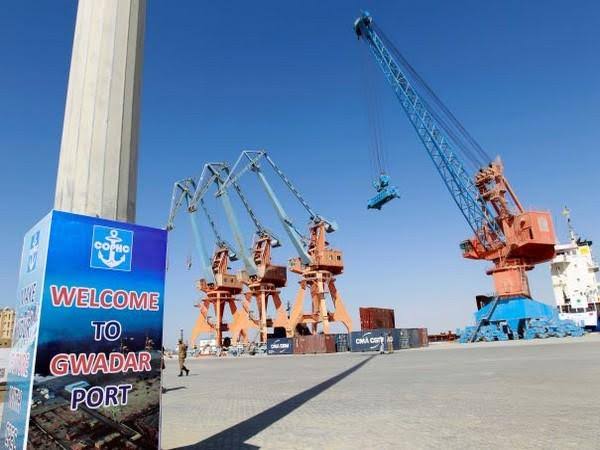Chinese Power Projection dream from Gwadar Port should be checkmated by developing Deesha air base and porbandar naval base

By
Colonel Awadhesh Kumar
The Chinese are planning to project military power in a big way over the Indian Ocean using Pakistan’s western coast, as reported by the Washington-based US Institute of Peace.
Chinese developing a naval base facilities at Gwadar has full support within Pakistan’s strategic planners and thinkers. Various fears of Pakistan in providing naval access to PLAN through Gwadar both in peace and as wartime contingency appear to be reducing over time. Economic dependency on China seems to be playing a major role in this. Fear of USA has now reduced to the minimum and they are always ready to bark at India till they get whacked nice and proper.
China now might even be permitted to deploy its PLA Navy marine corps units to provide security to Gwadar port. Open-source satellite imagery analysis has detected Chinese complexes in Gwadar with “unusually high security”. This strengthening of security at the Chinese facilities could be an indicator of a covert militarised use of the port.
Though it is obvious that it is likely to become a full time target for Baluchistan Liberation Force. However now time has come for India to carry out all contingency planning for getting the maximum from this Baluch scenario to keep Gwadar totally neutralized.
The PLA Navy’s long-term goal is acquiring overseas berthing facilities for naval expeditionary force in the Indian Ocean, and turning Gwadar port into a PLA Navy base. Soon more PLA Navy staff is likely to be deployed in garb of training Pakistani submariners, maintain the port and subs, perform repairs, and provide logistical support, especially after the transfer of eight conventional Type 039 submarines by 2028.
USA by releasing various “reports “ is trying its best to frighten India regarding China’s trying to prepare for power projection in Indian Ocean by developing Gwadar and other ports as Naval bases. They think that because of this India will be ready to develop Quad as a military alliance. They are highly mistaken.
Do these Americans think that all this while India will just be sitting quiet ? When USA and NATO were building up forces in Middle East for Invasion of Iraq, Sadam took no offensive action.
Well the above will not be the case with India. Suitable warning will be given to Pakistan to lay off. Then at first sign of open hostilities Gwadar will be simply obliterated. Even the Chinese know this will happen.
Most probably Gwadar, is not likely to become a PLA Navy base; rather, it is more likely to have berthing utility for China in peacetime by providing pier space and facilities for replenishing fuel and supplies.
Though the conspicuous absence of commercial activity at Gwadar raises the suspicions of covert naval activities without economic disruption and with greater concealment from foreign observation.
It is well known that Gwadar port is managed by the China Overseas Port Holding Company-Pakistan. This Company is legally required to support PLA overseas operations if called upon to do so. Even though the PLA Navy at present appears to prefer making port calls in Karachi, some Chinese officials boast of Gwadar as a turnkey military facility.
China may have plans to ultimately develop the Gwadar into a naval port, but its purpose remains unclear. One explanation is that China does not yet know what it wants but is establishing a presence as a form of contingency planning. In many ways, this is similar to the US approach in the Indo-Pacific of building partnerships, creating access, and putting in place logistical arrangements that can be operationalised in high-end contingencies.
China could leverage an Indian Ocean naval facility for a number of missions, ranging from non-combat and counterterrorism operations up to intelligence collection, coercive diplomacy, and even support for conflict operations.
Even in the absence of a definite view on China’s part, Pakistani strategists have been suggesting that “the potential for Gwadar to be used in support of future Chinese naval operations is also very real”. Pakistan military analysts and officers have talked of potential military-strategic rationales for China to transform Gwadar into a PLA Navy military base.
The most commonly cited aim is energy security, that is, as insurance against a blockade of the Strait of Malacca, a crucial shipping route for importing petroleum and liquefied natural gas by China. Even though overland transit is still very difficult, vulnerable to disruption and is cost-prohibitive, transporting oil overland from Gwadar to China’s Xinjiang region will still be an alternative route against such contingencies.
A Pakistani strategist proposed that “Pakistan would give a naval base to China at Gwadar Port to minimize the cost of transportation of oil to China”; another specified that it “can serve as an alternate to the sea route that passes through the Straits of Malacca”.
Another reason for developing a PLA Navy base at Gwadar might be to constrain the Indian and US navies. As per Pakistani military “Naval facilities or foothold on the Arabian Sea Coast could provide the Chinese a forward base to monitor US naval activity in the Persian Gulf region and Indian naval activity in the Arabian Sea”. Pakistan thinks that a militarized Gwadar would check both the Indian Navy and the US Navy in Indian Ocean.
However everyone should know that at the maximum China cannot bring in and sustain a PLAN Flotilla of more than 7 to 8 destroyers / frigates and one or two submarines. These can easily be taken care of by the Western Naval fleet of India.
As per the American report, both China and Pakistan dream of confining the Indian Navy to the Western Indian Ocean to limit its ability to threaten China’s sea lines of communication or to join a US-led military coalitional effort in the Pacific. An enhanced attack submarine presence could then be leveraged to threaten US capacity to swing US forces from the Persian Gulf, the Mediterranean, and the island of Diego Garcia in the Chagos Archipelago to the Pacific, particularly in a conflict over Taiwan.
The most aggressive motive cited, however, is that PLA Navy basing in Gwadar could serve as a source of power projection to strengthen China’s own blockade or maritime interdiction of the Strait of Hormuz as a horizontal escalation response to a US blockade of the Strait of Malacca.
The Indian Navy is growing as per its planned acquisitions, though this needs to be certainly speeded a bit. Also in response to Gwadar, India must develop a Flotilla level naval base at Porbander or somewhere at the mouth of the Gulf of Khambhat.
Also Deesha airbase needs to developed for basing a Sukhoi squadron upgraded to carry BRAHMOS missiles. So that if the need arises then right at the start, Gwadar can be brought under saturation attack from waves of BRAHMOS fired by Sukhois, followed by Naval Rafale sorties from INS VIKRANT and a visit by deep penetration Jaguars from Jamnagar. Finally a naval task force ex Porbander can pay the final visit to re enact the 1971 Karachi type raid on Gwadar.



